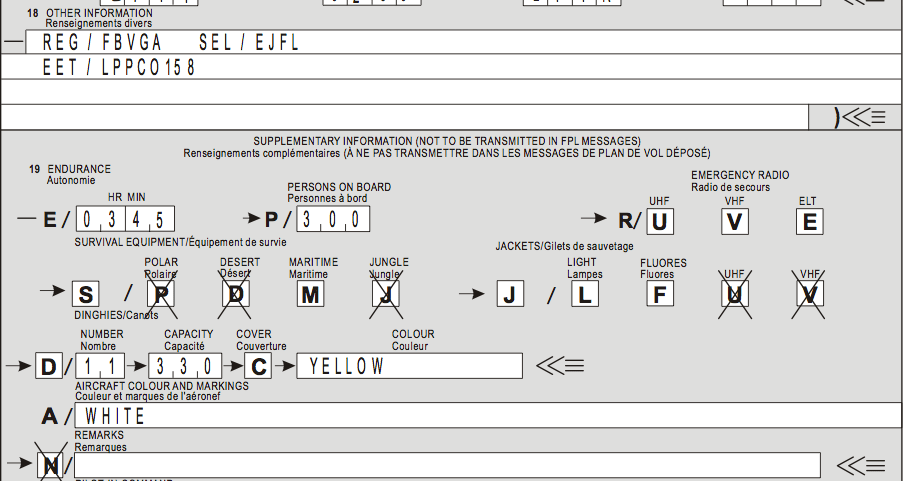¶ Introduction
A flightplan is a document which is sent to ATS (Air Traffic Services) and It includes many informations about a flight or portion of a flight
The term “flight plan” is used to mean variously, full information on all items comprised in the flight plan
description, covering the whole route of a flight, or limited information required when the purpose is to obtain a clearance
for a minor portion of a flight such as to cross an airway, to take off from, or to land at a controlled aerodrome.
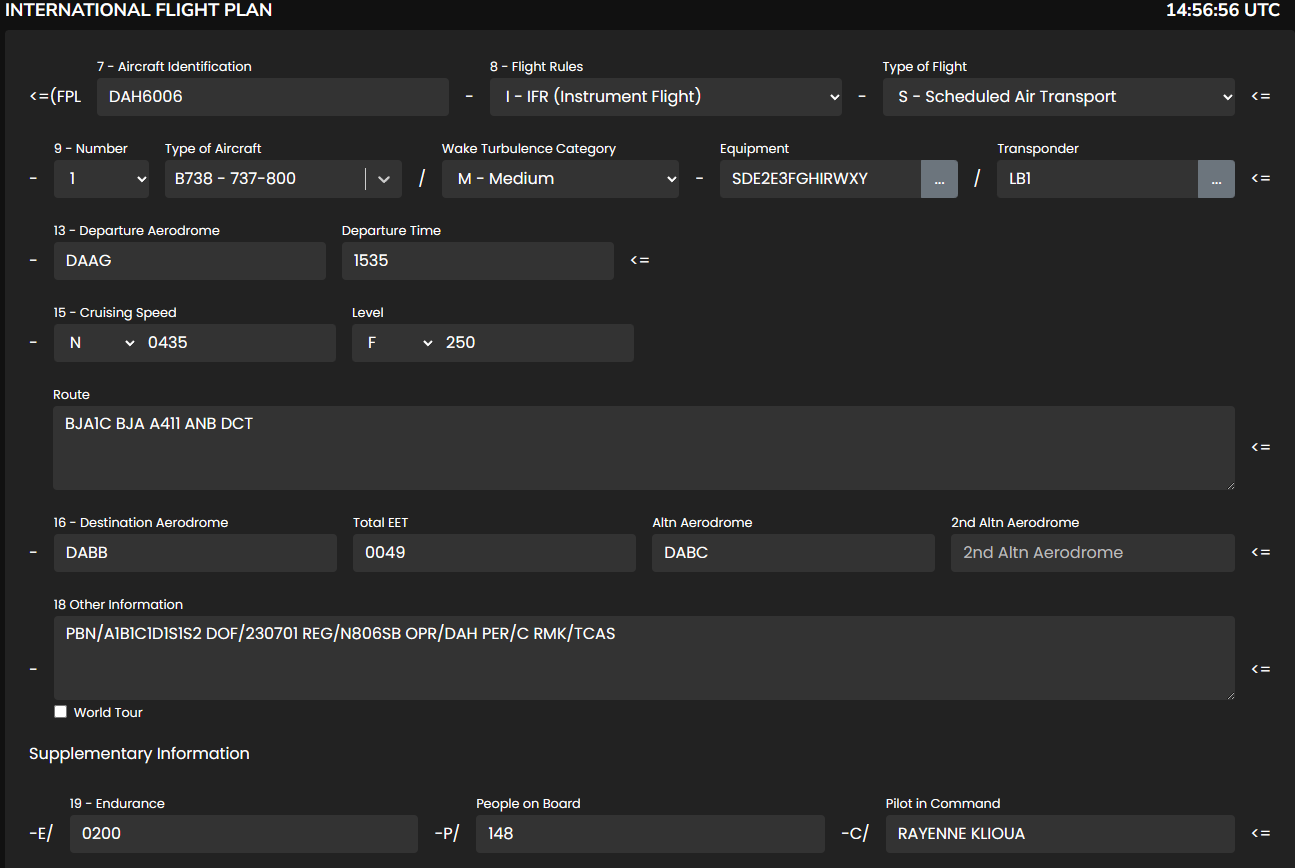
¶ When we send a flightplan?
A flightplan shall be sent prior to operating :
- Any flight or portion thereof to be provided with air traffic control service.
- Any IFR flight within advisory airspace.
- Any flight across international borders.
In the network before doing any flight IFR/VFR...etc the pilot shall send a flightplan.
¶ Contents of a flight plan
A flight plan shall comprise information regarding such of the following items as are considered relevant by the appropriate
ATS authority:
- Item 7 : Aircraft identification
- Item 8 : Flight rules and type of flight
- Item 9 : Number , type(s) of aircraft and wake turbulence category
- Item 10 : Equipments
- Item 13 : Departure aerodrome
- Item 13 : Estimated off-block time
- Item 15 : Cruising speed(s)
- Item 15 : Cruising level(s)
- Item 15 : Route to be followed
- Item 16 : Destination aerodrome and total estimated elapsed time
- Item 16 : Alternate aerodrome(s)
- Item 18 : Emergency and survival equipment
- Item 18 : Other information
- Item 19 : Fuel endurance
- Item 19 : Total number of persons on board
¶ Item 7 : Aircraft identification

This identification is your chosen unique call sign on IVAO Network.
It can be as follows:
- A registration marking of the aircraft as pronounced on the frequency : 7TVRK, FGZHA
- An ICAO designator (trigram) of an operating company, followed by the flight number (plus letters) : DAH6006, AFR1856
- A special military call sign given by authorities: KJD102, USAF112, FAF020
¶ Item 8 : Flight rules
Them Item 8 regroup the flight rules and type of flight
This item is the flight rules chosen for the flight.
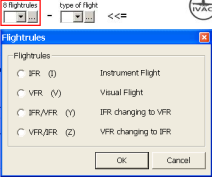
The flight rules must be chosen in the following list:
- I when the whole flight will be under IFR
- V when the whole flight will be under VFR
- Y when the first part of the flight will be under IFR and later changed into VFR
- Z when the first part of the flight will be under VFR and later changed into IFR
The flight rules are Instrument Flight Rules (IFR) or Visual Flight Rules (VFR).
Short explanation of VFR and IFR:
- V = VFR: Visual Flight Rules means the pilot is required to be able to see ground reference except
where the local authorities allow differently. It is the rule of "see and be seen". The ceiling and the
visibility shall be compatible with the flight - I = IFR: Instrument Flight Rules means the aircraft instrumentation and the pilot abilities have to be
certified. Instrument flight rules allow pilots to fly through clouds and in poor visibility. In most of the
cases separation is provided by ATC in controlled airspace
The pilot should specify in the appropriate route item the point or points where the change of flight rules is
planned.
Example: GIBAL W616 LXR VFR DCT.
This means the flight will depart IFR and remain IFR till LXR, after LXR the flight will continue VFR
Example: GIBAL/N0260F120 IFR W616 LXR.
This means the flight will depart VFR and remain VFR till GIBAL, after GIBAL the flight will continue at a
speed 260 kts at FL120, IFR.
¶ Item 8 : Type of flight
This item is the type of flight.
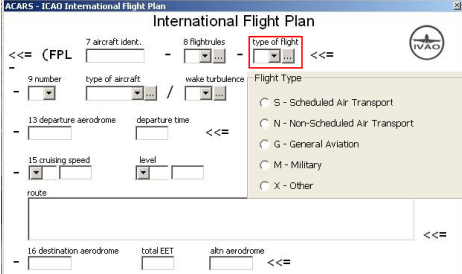
This one letter type must be chosen in the following list:
- S if scheduled services (commercial flight according time-table)
- N if non-scheduled Air Transport Operations (occasional commercial flight)
- G if General Aviation (non-commercial flight)
- M if Military
- X if other than any of the defined categories above (State Flight, Search And Rescue, …)
¶ Item 9 : Number
Them Item 9 regroup the number , type of aircraft and wake turbulence category
This item is the number of aircraft in the formation.
In IVAO, this number shall be 1 except for formation flight with multiple aircraft.
Be careful, do not mix, fly with other aircraft, perform own navigation and make a visual separation between each other and a formation flight that all the aircraft must be close to each other and doing the same thing
at the same moment.

¶ Item 9 : Type of aircraft
This item is the code of the aircraft you use in the IVAO Network.
The aircraft is coded using the ICAO table given by FPL IVAO.
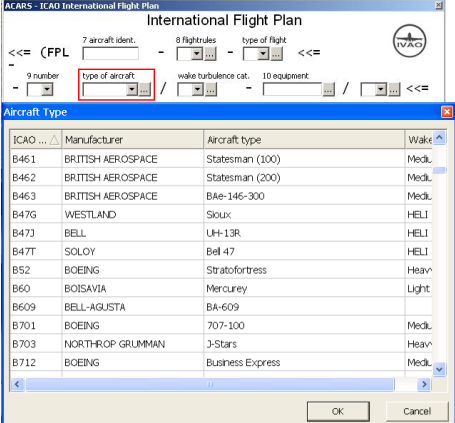
If an aircraft type has no ICAO code, you must use ZZZZ in the type of aircraft cell and you must specify in
Remarks (item 18) the full name of the used aircraft type preceded by TYP/
¶ Item 9 : Wake turbulence
This item is the wake turbulence category of the aircraft chosen in the flight plan.
It is coded using one chosen letter with the following possibilities:
- H = heavy: for an aircraft type with a MTOM of 136.000 kg (300.000 lb.) or more.
- M = medium: for a MTOM less than 136.000 kg but more than 7.000 kg (15.500 lb.).
- L = light: for a MTOM of 7.000 kg or less.
For each aircraft type, the wake turbulence category is determined by its MTOM = Maximum Take-Off Mass. The actual mass of an aircraft does not change its wake turbulence category.
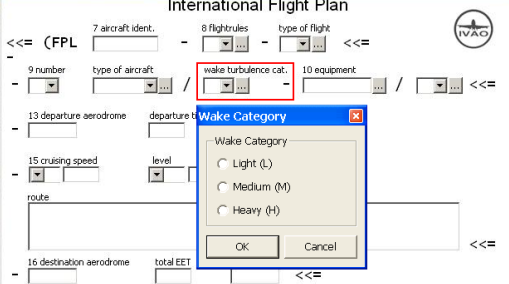
¶ Item 10 : Equipements

Equipement : this item is the equipment used, carried and serviceable for the current flight.
Transponder : this item is the SSR (transponder) equipment used, carried and serviceable for the
current flight.
For a better explication see the section see also of table which is in the top down of this page.
¶ Item 13 : Departure and estimated departure time
 .
.
This item is the ICAO code of the departure aerodrome. The ICAO code is noted using maximum 4 letters.
In IVAO, the ICAO code is mandatory. No IATA or Airfield names are allowed.
If no location identifier is assigned, you must use the special code ZZZZ and the exact name of your airfield in plain language should be specified in the ‘other information’ item, preceded by DEP/ text.
The Estimated Off-Block Time (known as departure time) is the estimated time at which the aircraft will commence ground movement associated with departure.
It is coded using 2 digits for the hour followed by 2 digits for the minutes.
All hours must be calculated in UTC time for all countries.
¶ Item 15 : Cruising speed(s)
Them Item 15 regroup the cruising speed , cruising level and route to be followed

This item is the cruising speed for the first or whole portion of the flight.
The cruising speed is the True Air Speed expressed in one of the three possible units:
- N = Knots: N followed by 4 digits which will be the speed in knots (N0220 = 220KT)
- M = Mach: M followed by 3 digits which will be the mach number without the dot character (M079 = 0.79 Mach)
- K = km/h : K followed by 4 digits which will be the speed in kilometre per hour (K0350 = 350km/h)
ICAO provision is to apply a Mach number notation only above FL250.
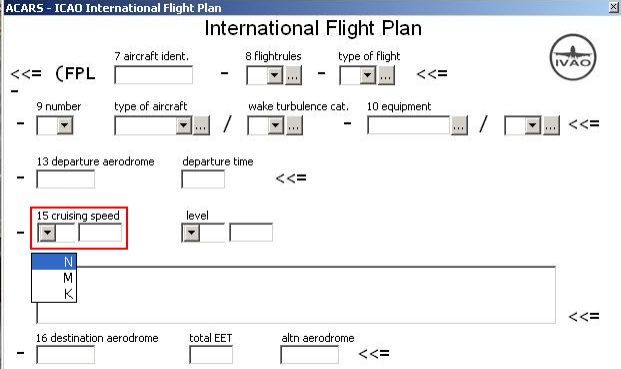
The speed value K or N is selected for the first part of the flight. If the required value changes en route, the speed/level field for level changes should be stated in the route next to a fix.
Mach number is only given for flights in those airspaces where ATC prescribes (big example: North Atlantic.) There is no Flight Level above which Mach must be filed.
¶ Item 15 : Cruising level(s)

This item is the cruising altitude or flight level for the first or whole portion of the flight.
The cruising altitude or flight level is expressed in one of the three possible units:
- F = flight level: followed by 3 digits expressed in hundreds of feet above transition altitude.
(Example: F130 = 13000ft). - A = altitude: followed by 3 digits expressed in hundreds of feet below transition altitude. (Example:
A025 = 2500ft). - S = standard metric level: followed by 4 digits expressed in tens of meters above transition altitude
(Example: S1130 = 11300m) - M = metric altitude: followed by 4 digits expressed in tens of meters below transition altitude
(Example: M1130 = 11300m) - VFR = VFR level: it is used when no specific VFR altitude chosen.
The letters S and M are used only in some countries. It depends of the local regulations.

Note that VFR level is usually set when a VFR flight is performed below 3000ft where altitude is free to use.
¶ Item 15 : Route
This item is the route followed by the aircraft during its flight.
Aircraft routing types used in flight planning are:
- Airways
- Navigational Aids
- Direct.
- SIDs and STARs
A route may be composed of segments of different routing types.
The route can include:
- Fixes (5 character points) overflown (SALMA,MAHDI)
- Airways (UG6, A411, UJ7) which are pre-defined pathways
- Navaids (short for Navigational Aids)
- SIDs and STARs which are procedures and checkpoints used to enter and leave the airway system by aircraft operating on IFR flight plans
- Changes of speed and level/altitude (N0250F180)
- Changes of flight rules (Y / Z flights)
- Geographic Coordinates (55N030W)
For a flight outside designated routes, points should be shown normally not more than 30 minutes flying time apart, or 200 nm apart, including each point where a change of speed, level, and track or flight rules is planned.
Between all these points, DCT shall be inserted, meaning that the pilot will fly direct between these two points (example: SALMA DCT BAVON DCT BALON)
For VFR, commonly used visual reference points are inserted to indicate the intended flight path. (See the
appropriate VFR navigation charts.)
¶ Item 16 : Destination aerodrome and total estimated elapsed time
Them Item 16 regroup the destination aerodrome , total estimated elapsed time and ternate aerodrome

This item is the ICAO code of the arrival aerodrome. The ICAO code is stated using maximum 4 letters.
In IVAO, the ICAO code is mandatory. No IATA or Airfield names are allowed.
If no location identifier is assigned, you must use the special code ZZZZ and the exact name of your airfield
in plain language should be specified in the ‘other information’ item, preceded by DEST/ text.
The Estimated Elapsed Time (EET) is the time calculated:
- Between take-off time and the estimated time overhead the arrival aerodrome calculated for VFR flight rules
- Between take-off time and the estimated time at the expected IAF for IFR flight
It is coded using 2 digits for the hour followed by 2 digits for the minutes.
All hours must be calculated in UTC time for all countries.
¶ Item 16 : Alternate aerodrome(s)

This item is the ICAO code of the alternate aerodrome. The ICAO code is stated using maximum 4 letters.
The alternate aerodrome is used when your aircraft cannot land in the destination airport.
In IVAO, the ICAO code is mandatory. No IATA or Airfield names are allowed.
If no location identifier is assigned, you must use code ZZZZ and the exact name of your airfield in plain
language should be specified in item 18, the ‘other information’ item, preceded by ALTN/ text.
An alternate is optional for VFR flight rules unless local authorities require such.
¶ Item 18 : Emergency and survival equipment
Them Item 18 regroup the emergency and survival equipment and other information
In IVAO you will never use the emergency and survival equipment.
¶ Item 18 : Other information

This item includes all other information needed for the flight which is not present in the other items.
Example of some important remarks:
If you have no FMC, please insert “RMK/NOFMC”
If your aircraft has no RNAV capabilities, please insert “STS/RNAVINOP”
If your aircraft is not RVSM, please insert “STS/NONRVSM”
If any other necessary information is required, then in the preferred sequence shown below, the form of an
appropriate indicator should be stated, followed by an oblique stroke and the information to be recorded.
Be advised that the following remarks have very little use on IVAO.
IVAO recommended practices (NOT applicable for IVAO exams):
If you are a Newbie in the IVAO network, please insert “RMK/IVAO Newbie” in this item.
If your call sign of your company is not well known to ATC, please insert “CS/company_radio_call”
¶ Item 19 : Fuel endurance
Them Item 19 regroup the fuel endurance and total number of persons on board

You fill the fuel endurance in hours and minutes (4 digits). It means the range of your aircraft in terms of flight hours.
¶ Item 19 : Total number of persons on board

The total number of persons (passengers and crew included) on board, when required by the appropriate ATS authority.
¶ Item 19 : Pilot in Command

Pilot in command), you must fill in your real name and surname. The same name that you provided when you completed your IVAO registration form
¶ Example of flight plan
¶ Flight DAH1154 with B738 from DAAS to LFLL
(FPL-DAH1154-IS
-B738/M-SDE1FGHIJ1M1RWY/LB1
-DAAS0800
-N0450F360 STF BJA UN736 BALEN UM154 SOSUR UM976 MTL
-LFLL0130 LFML LFMN
-PBN/B1C1D1O1S2 DOF/230105 REG/7TVKP EET/LFFF0026 SEL/JQMR CODE/0A008F IFP/MODESASP ORGN/DAASZPZX)
¶ Flight DAH2700 with A332 from DAAG to CYUL
(FPL-DAH2700-IS
-A332/H-SDE1E2E3FGHIJ2J4J5M1P2RWXY/LB2D1
-DAAG1140
-N0472F340 SADAF1C SADAF UL45 URIPO/N0468F360 UL45 VLC/N0470F350
UN733 DESAT/N0468F360 DCT STG DCT PASAS/M082F360 DCT
46N020W/M082F360 46N030W/M082F380 46N040W 46N050W/M082F380 DCT
SUPRY/N0463F380 N120A MIILS/N0470F400 DCT KOBEK OMBRE9
-CYUL0901 CYYZ CYQB
-PBN/A1B1C1D1L1O1S2 SUR/RSP180 DOF/211207 REG/7TVJA EET/LECB0015
LECM0044 EGGX0215 20W0303 CZQX0409 40W0512 ADIZ0556 50W0610 CZQX0616
CZQM0702 KZBW0810 CZUL0828 SEL/HKEF CODE/0A0084 RALT/LPLA CYQX
TALT/DAOO RMK/TCAS EQUIPPED RVR175)
¶ Flight DAH2024 with B736 from DAAG to LIRF
(FPL-DAH2024-IS
-B736/M-SDE1FGHIJ1M1RWY/L
-DAAG0945
-N0451F360 BOUR1A BOURI UM986 ORKUM UM603 ELSAG DCT ALG DCT TINTO L5 VALMA
-LIRF0132 LIMC LIRN
-PBN/B1C1D1O1S1 SUR/TCAS DOF/221222 REG/7TVJS EET/LFFF0031 LIRR0049 SEL/HLGP CODE/0A0026 RVR/175 IFP/MODESASP ORGN/DAAGZPZX TALT/DAOO)
- ICAO Annexe 2
- VID 489972 - Creation




